Adventures in the Ecuadorian Amazon Part 2
Since the beginning of time, we have been the guardians and the healers of the forest. We have too long forgotten the magic powers of nature. The time has come to call on them again. Remember: all the magic of creation exists within a single tiny seed.
-Magi Lune, Ferngully, 1992
We are disconnected from nature and surrounded by concrete and noise. Too often, we forget the mystery and magic of the natural world, and get caught up in the monotony of our day to day nine to five. Wild places on earth are shrinking with every day, every molecule of greenhouse gases emitted. To visit somewhere truly wild is a gift, and these days in the Amazon were a treasure trove.
There is a difference between vacation and travel, and this was not a vacation. This was a conglomeration of cultural and educational experiences that will leave an indelible mark on me. It was awe-inspiring and breathtaking, but carried a profound and sobering weight. I was inspired to do my part, but helpless at thinking how small that part would be and how little one person could do…at least I can donate to organizations that are working every day to save, preserve, and replenish the rainforest, and I can make changes in my life to decrease my environmental impact. So can you. The Rainforest Foundation has a list of 10 things we can do..
Some of the things are really simple, like reducing beef consumption and choosing sustainably sourced food products. If we all did this, maybe we’d start to see change.
Off the soapbox… on to our adventure! See pix from our trip here, and while you’re at it, like my FB page!
Arriving at La Selva Eco Lodge
While the motorized canoe ride was fun, the real adventure began when we boarded the paddle canoe with our bilingual guide, Andres, and our local guide, Guillermo (henceforth known as Gijo). As Sara, Vuong, and I walked the path from the gazebo by the pier on the Napo River, the sounds of the main river faded and we were enveloped in the warm hug of the forest (that would be intense humidity).
The Stinky Turkey
We glided down the creek, the only sounds were the swish of the paddle and the chirping and whistling of jungle birds welcoming us to their Eden. Right away, one sound stood out from the rest- it didn’t really sound like a bird, more of a grunt or squawk. This was a common, yet beautiful and oh-so-strange bird called the Hoatzin. This bird’s nickname is the “Stinky Turkey,” and it has a unique story. It is a large bird that resembles a turkey, with feathers in autumnal shades of oranges and browns and a shock of blue around the eyes. It has a spiky mohawk and a sassy attitude.
The really interesting part is why it is stinky…their digestion is similar to that of a cow. They eat lots of leaves and don’t have teeth. They store the ingested material in a specialized compartment of their foregut (called the crop, AKA craw) where it is ground up and fermented. They burp up the off-gases, emitting a foul odor and causing them to exist in a cloud of stench, which calls to mind Pigpen from Charlie Brown. Because of this (and because the meat tastes bad and may contain calcium oxalate crystals that can harm us), humans rarely eat them. There is also evidence that these birds may be closer relatives to the dinosaur than others…
Despite their bad reputation, we found them funny and beautiful. They were present for most of our excursions and witnessed most of our animal sightings!
Soon, the canals opened up to Garzacocha Lagoon, AKA Heron Lake. It was a beautiful body of water, its glassy surface reflecting the verdant flora, azure sky, and fluffy white clouds. Soon, the lodge came into view and we paddled for home!
- These were the motorized canoes we rode to La Selva
- Hoatzin, AKA “Stinky Turkey”
- Our Amazing Amazon Guides, Andres and Gijo
The Lodge
Miguel and his staff welcomed us warmly with cool towels, cold drinks, and information. I’ve already described the lodge in Part 1, so I’ll get right to the adventures!!
Activities
Every day had a similar rhythm, matched to that of the rainforest. Up at dawn for breakfast and an activity. Back for lunch and a nap. Afternoon activity, then dinner, then early to bed. This allowed us to be out and about when the animals were most active, and inside and resting for the heat of the day and the inevitable afternoon rains.
Canoe Rides
I’m a water baby, so these were my favorite! We paddled at least once every day… well, we didn’t paddle… Andres and Gijo paddled us around! We’d paddle around the periphery of the lake, then down the creek a ways before turning around. Every day and night brought something new.
The first time I heard howler monkeys was shocking! It sounded more like a growl heard across the entire lake, in every room of the lodge, maybe even back home in Arkansas. It started low, like air whooshing through a wind tunnel, and crescendoed into a guttural rumble I could feel in my sternum. They use this sound to communicate with each other, defend their territory, attract mates, and scare the crap out of tourists. Pathology/anatomical note of interest- they have enlarged hyoid bones which transform their throats into echo chambers, amplifying the sound. They change the shape of their mouths and lips to perfect the sounds.
Our guides had uncanny skills in finding animals. Once, while floating down the creek, Gijo directs our attention to an invisible blob high in the trees. We crane our necks, Andres paddles back and forth, and finally we see it- a small brown blob at the base of a branch high in a cecropia tree. It was a two-toed sloth (we couldn’t actually see his toes, but our guides knew the species)! We could see it through binoculars, mostly because it began to move. So. Very. Slowly.
Squirrel monkeys were less difficult to spot. Look for moving branches high in the forest, and you’ll find something. Usually, what we found were huge troupes of squirrel monkeys, swinging from tree to tree and running down impossibly thin branches, sometimes falling long distances, popping back up and gesturing “I’m Ok!” Sometimes, we’d see Capuchin monkeys, night monkeys, or titi monkeys.
Night canoe rides were especially fun. With the setting sun, the diurnal animals went into hiding and the night shift began to stir. The greens faded into blacks, the sky began to darken, and the sideways crescent moon took her place in the night sky. Andres and Gijo shone their powerful torches around, sweeping the edge of the water and the trees quick enough to they didn’t disturb the wildlife but could pick up the flash of reptilian eyes. We started to notice quick flashes close to us in the beams of the headlights, and we all knew what they were- bats! The ones we were seeing were mostly Bulldog Fisher Bats. We didn’t get an up close view of these creatures, but if you google them you’ll see how ugly these poor things are! Their faces really do look like bulldogs! It was unbelievable how well these guys could camouflage themselves on a branch sticking out of the water in plain sight!
You could tell when our guides spotted something… they would hurriedly speak to each other in Spanish or Kichwa, their flashlight beams would come together, and they would paddle toward the combined beam. Voices became whispers, and the three of us would peer into the light, seeing nothing.
Usually, the reflected flash would be the eyes of a Black Caiman, peering menacingly at us from just above the waterline. This time, our guides were looking into the trees…Andres whispers “this could be nothing, or it could be something really cool.” It was something really cool. Our canoe was right against the trees- I was a little worried about spiders or other creepy crawlies creeping and crawling on me. We got even closer to the trees, into the branches really, when Andres pointed it out to me. It was an Amazon Tree Boa! He was a beautiful baby, coiled around the branch of a mangrove. His back was gray, with beautiful markings, and his underbelly peachy-pink. My life was complete. Well, almost… I really would love to see a Giant Anaconda! This actually happened twice!
Once, we took a walk to another lake, where we paddled down trails cut between vast growths of water lilies. Dragonflies, butterflies, and birds flitted about as we made our way gently through to creeks meandering through the deep jungle. We heard giant otters, but were unable to reach them- the streams gradually petered out, forcing us to paddle backwards to get back to the main channel. We also heard an ocelot closer to the lodge, but never got to see this elusive big cat.
- Mushrooms in Garzacocha Lagoon
- Amazon Tree Boa
Jungle Walks
We took several walks through the jungle near the lodge- both daytime and night time. We learned so much about the flora and the ecosystem on these walks, and how everything is interconnected.
The canopy kept the trails relatively cool, but the humidity was palpable. The rainforest produces most of its own rain through an amazing cycle. Basically, they absorb water and nutrients from the soil. They release water through pores in their leaves through a process called transpiration, and water also evaporates from lakes and streams. The water forms clouds you can actually see dotting the horizon in the forest. The water eventually condenses and causes humidity and rainfall.
As for the nutrients. When leaves fall to the ground, they decompose with the assistance of fungi. This puts nutrients into the soil, which are again absorbed by the trees. The understory is the part of the forest underneath the canopy, and it is usually relatively cool, dark, and damp. Sometimes, trees fall down due to lightning, wind, being dead, etc… These trees are often huge. When they fall, they create a gap in the canopy which allows sunlight in. The combination of rotting tree and sunlight allow new life to flourish. We saw so many different beautiful mushrooms growing on felled trees, helping them decompose and give back to the earth. Beetles and other bugs lend a hand.
Plants attract the animals they need to distribute seeds and ways of keeping away others. Pretty, sweet-smelling flowers attract bees and butterflies, while stinky flowers (example- the corpse flower) attract beetles and flies. Thorns, spines, spikes, etc keep larger animals away. Everything is interconnected, and the primary goals of life are to survive and reproduce.
Speaking of being interconnected, what about mycelia?! Mycelia are basically the roots of fungi which can form complex underground networks that make a sort of mat. They aid in decomposition, preventing erosion, and have lots of applications and potential applications in agriculture and manufacturing. These can form some of the largest living organisms on earth and can communicate with other plants, forming complex symbiotic relationships.
Ants form up to 30% of the entire biomass of the forest. As we walked, while the atmosphere was still yet charged with potential, the ground was never fully still. As we looked down, there was always movement. Most of this movement was due to ants. We saw several fascinating types of ants, the most interesting possibly being the Leaf-Cutter Ant. These guys are the farmers of the ant world. They have underground “gardens” of a special type of fungus they need for survival. This fungus needs a certain type of leaf to survive, but they cannot walk to get it. So, the ants do it for them. We saw long columns of ants marching with fragments of leaves on their backs, all converging to the entrance to their underground lair. They bring the leaves to their fungus gardens, fertilize and grow the fungus, then feed on the fungus. This mutually beneficial relationship provides protection and nourishment to the fungus, which in turn feeds the ants.
Next to the leaf cutter ant colony, we saw a strange structure that looked like a periscope made of mud. This was the entrance to a hive of ground bees, which often nest next the the leaf cutter ants, because the ants protect their mound from predators and thus function as an inadvertent bodyguard for the bees, providing them a safer home for their babies (larvae).
Speaking of fungus with ulterior motives… you may have heard of or seen the series “The Last of Us.” This was based on a cracked-out form of a type of cordyceps fungus that takes over humans to use them to carry out its life cycle. While it seems farfetched, the premise is actually based in reality. This mushroom usually infects ants. The fungus grows inside of the ant, taking over its organ systems including the nervous system. By mechanisms which are still unclear, it manipulates the ant’s behavior to serve its own means. It directs the ant to a location in which it can grow, kills the ant, and sprouts a fruiting body out of its head. It grows, infects other ants, and the cycle continues. Isn’t nature amazing? Easy to see how this could hatch a plot for a zombie series!
And speaking of ants…
Bullet Ants pack the most painful sting of any insect! Andres could attest to this, as he had been bitten twice. These buggars can grow up to 1.2 inches in length! The ones we saw were probably about that size! They are reddish-black, shiny, and live in colonies but usually travel alone. They have large, powerful mandibles with which they grab their prey, using their tail stinger to inflict pain (and kill smaller creatures). While they aren’t usually aggressive, that changes if they feel threatened. Their sting induces excruciating pain that can last up to 24 hours and be accompanied by fever, chills, and malaise. If you haven’t figured it out, they are called “bullet ants” because their sting feels like being shot!
Lemon ants nest in the hollow stems of a certain type of tree and emit a lemony scent. Some indigenous people eat them, and our guide Andres helped himself to a snack. I tried, but could not get past the creepy crawly ones on my hand…eating them is not recommended. They are not approved by the FDA lol.
There were also army ants, carpenter ants, and so many other ants, each with their fascinating characteristics. Termite mounds in the Amazon are different than those we saw in Africa. Most of the ones we saw were arboreal, or found in/on the trees.
Lianas are woody vines that connect the trees and form the network that lends impenetrability to the canopy. These vines begin life as small shrubs which grow upwards toward the sun, using the trees as a ladder which they hug gently. They usually don’t take nutrients from the trees, as this would be counter to their goals. Instead, they provide a habitat for other plants, called epiphytes, and animals to set up their homes.
Epiphytes are plants that grow on other plants and get their water from the atmosphere and rain, and their nutrients from debris and animals. You probably know about lots of epiphytes, such as orchids and bromeliads. We saw these everywhere in the rainforest, growing on lianas high in the kapok trees, adding a pop of color and micro-habitat for small creatures. These plants often have reservoirs for water, and life always finds water. Tiny animals and plant forms set up their homes in the water, and their waste products provide nutrients for the plants.
Strangler figs are one of the many strange and wonderful things in the Amazon. They are “hemiepiphytes” who start life as sweet, benign epiphytes. Their plans are far more nefarious… they send roots up and down, seeking light from the sun and reaching down toward the soil for nutrients. As their roots grow, however, they begin to strangle their host tree, eventually sucking out its life force and killing the tree (in some cases). You’d think this was a self-defeating behavior, but the vine is so strong that once the supporting tree dies, it can support itself. This ends up forming a hollow column which is a very unique appearing thing and provides additional habitats for some animals.
We saw other living things on our walks…
Some were the stuff of nightmares. We saw two Goliath Tarantulas. These are those infamous bird-eaters that grow up to 11 inches in diameter (the size of a dinner pate!!). We only saw three of the adult’s furry legs sticking out of the entrance to its lair, a large, foreboding hole in the ground. But we saw the entire “baby,” which could eat a Texan wolf-spider for a mid-afternoon snack! They typically eat insects (not birds) and aren’t particularly harmful to humans except for their hairs, which can irritate the skin and eyes… and, they could cause heart attacks or fatal accidents when trying to escape.
Speaking of wolf-spiders, the Amazonian wolf-spiders were nightmare-inducing on their own. Social spiders didn’t make me feel lovey dovey either. The golden orb spider is beautiful but creepy, and the silk of its web so strong that it is being studied for use in medical sutures and bullet-proof vests.
Our night walks revealed several cute little tree frogs and one humongous not-so-cute toad who thought he blended in with the soil…like he closed his eyes, sat very still, and thought “you can’t see me, you can’t see me!” We did not spy the elusive poison dart frog. We saw a cute little blunt-headed snake, who looked like two different snakes stitched together- the front end was brown and white striped and the back end more patchy and grey/tan.
We encountered a baby kinkajou, which was a precious little Mahogany colored raccoon like creature who seemed to want to be chased. We saw a pygmy marmoset, an elusive tiny little monkey that zipped around in the top of the trees, allowing us occasional glances.
- One Tree’s Defenses
- Blunt-Headed Snake
- Amazonian Wolf Spider
Come back next time to read about our visit to the indigenous people’s village where we eat grubs, and about our encounters with more iconic Amazonian creatures! You may wonder why I haven’t talked much about birds… Also saving them for next time!
More photos to come! I’ll add them to a gallery under the “Ecuador” section!


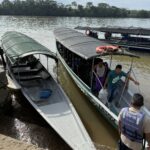
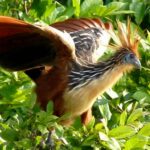
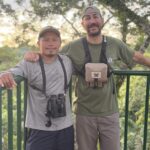
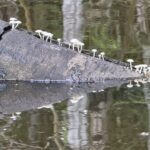
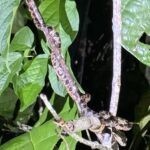
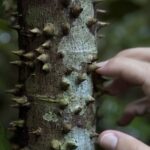
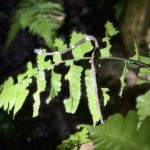
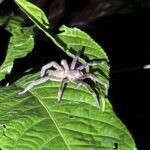

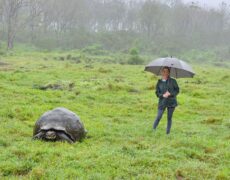
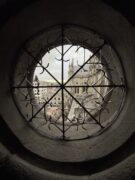
0 Comments